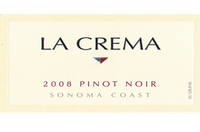La Crema Sonoma Coast Pinot Noir 2008 ($24): Many wine drinkers enjoy Pinot Noir wines because they are flavorful, fruity and not so tannic as Cabernet. What I love about Pinot Noirs is their diversity. Even a limited group of Pinot Noir wines -- all New World, say, or even all from California -- can present a fascinating range of dryness levels, weight and body, richness or delicacy of aromas and flavors, and personality, let alone the range of aromas and flavors themselves. I had a ball when I recently blind-tasted a dozen California Pinots, and was thrilled to discover that my favorite, this La Crema 2008, was also one of the least expensive wines in the group.
all from California -- can present a fascinating range of dryness levels, weight and body, richness or delicacy of aromas and flavors, and personality, let alone the range of aromas and flavors themselves. I had a ball when I recently blind-tasted a dozen California Pinots, and was thrilled to discover that my favorite, this La Crema 2008, was also one of the least expensive wines in the group.
La Crema is a Sonoma County winery founded in 1979 that specializes in Chardonnay and Pinot Noir, and also has a small production of Pinot  Gris and Syrah. Winemaker Melissa Stackhouse now makes three Chardonnays (Carneros, Monterey and Sonoma Coast) and five Pinots (Carneros, Monterey, Russian River Valley, Sonoma Coast and Anderson Valley). Of the Pinots, the Sonoma Coast bottling is the winery’s largest, representing 80% of its Pinot Noir production, and 25% of the winery’s total volume.
Gris and Syrah. Winemaker Melissa Stackhouse now makes three Chardonnays (Carneros, Monterey and Sonoma Coast) and five Pinots (Carneros, Monterey, Russian River Valley, Sonoma Coast and Anderson Valley). Of the Pinots, the Sonoma Coast bottling is the winery’s largest, representing 80% of its Pinot Noir production, and 25% of the winery’s total volume.
The designation “Sonoma Coast” here indicates the Sonoma Coast AVA, a large area that encompasses parts of Russian River Valley and Carneros, as well as the far coastal areas, sometimes called the “true coast,” that are prized for their extreme cool-climate growing conditions. Half of the grapes for this 2008 Pinot Noir come from Russian River Valley, which saw erratic weather in 2008, including some of the coldest temperatures in decades and a heat spike at Labor Day. The remainder of the fruit comes from vineyards in “true coast,” such as Annapolis and Bohan Dillan Road, and from Sonoma Carneros and southern Sonoma.
When I tasted this wine blind, I found it to be among the driest, most well-defined and best-balanced wines in the group that I had assembled. It was not the biggest or darkest wine, nor the oakiest, but it also was not the lightest. It showed itself to be a vibrant, fresh Pinot that spoke of a cool climate region. Here’s what to expect when you taste it yourself. The aroma is fresh and intense but not overpowering, with notes of red cherry, strawberry preserves, a citrus nuance and a gentle vanilla perfume.
In the mouth, the wine is dry and appropriately fruity, with enlivening acidity, silky texture, medium-plus body (lighter than many of today’s massive Pinots) and only a moderate amount of fine-grained tannin that emerges toward the back of your mouth. Flavors of tart red fruits with accents of orange peel and dried herbs are pronounced enough that you can enjoy the wine without food but not too intense to complement delicately-flavored dishes. The wine shows lovely concentration of fruit in a not-huge package. Its 13.9% alcohol seems not at all high, within the balance of the wine.
One aspect that sets this wine apart from other Pinots in its price category is that it does not taste “made.” In fact, the winemaking echoes traditional, artisan practices for Pinot Noir. Whole berries underwent a five-day cold soak before fermentation to capture aromatics and enhance color, followed by a moderately warm fermentation in small open-top tanks with punching down of the cap, and aging in French oak barrels, 26% of which were new.
If you love Pinot Noir and wish that you could afford to drink a good one more often, you need to taste this wine.